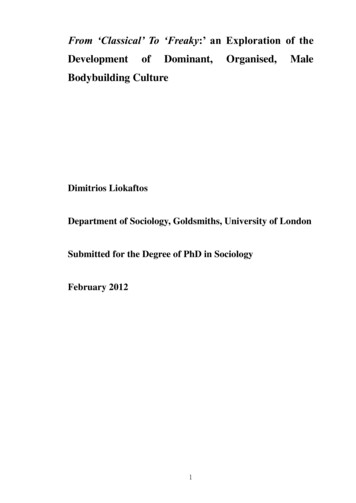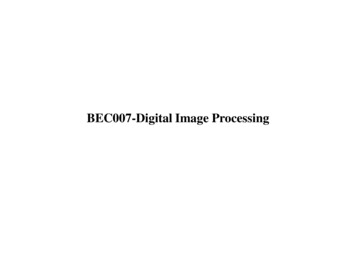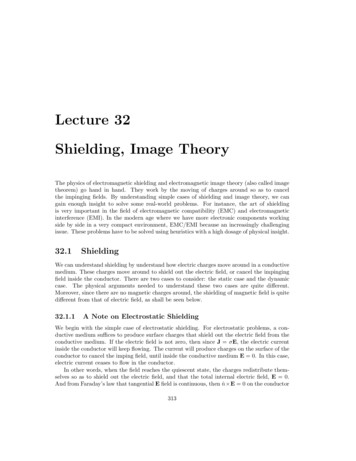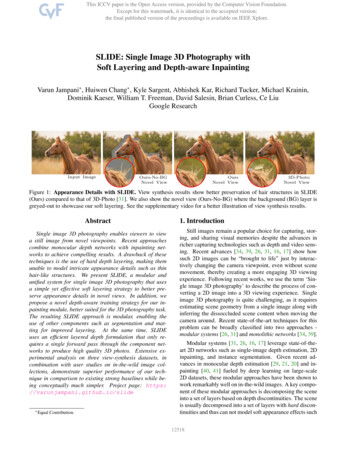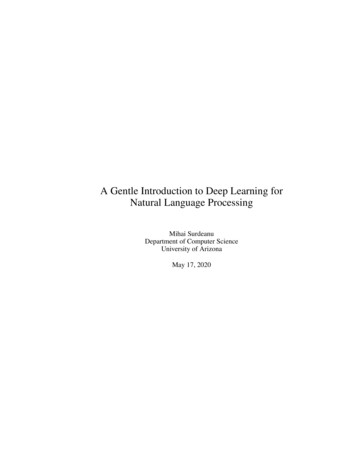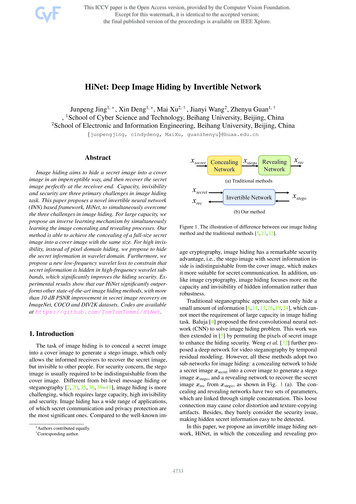
Transcription
HiNet: Deep Image Hiding by Invertible NetworkJunpeng Jing1, * , Xin Deng1, , Mai Xu2, † , Jianyi Wang2 , Zhenyu Guan1, †, School of Cyber Science and Technology, Beihang University, Beijing, China2School of Electronic and Information Engineering, Beihang University, Beijing, China1{junpengjing, cindydeng, MaiXu, guanzhenyu}@buaa.edu.cnAbstractImage hiding aims to hide a secret image into a coverimage in an imperceptible way, and then recover the secretimage perfectly at the receiver end. Capacity, invisibilityand security are three primary challenges in image hidingtask. This paper proposes a novel invertible neural network(INN) based framework, HiNet, to simultaneously overcomethe three challenges in image hiding. For large capacity, wepropose an inverse learning mechanism by simultaneouslylearning the image concealing and revealing processes. Ourmethod is able to achieve the concealing of a full-size secretimage into a cover image with the same size. For high invisibility, instead of pixel domain hiding, we propose to hidethe secret information in wavelet domain. Furthermore, wepropose a new low-frequency wavelet loss to constrain thatsecret information is hidden in high-frequency wavelet subbands, which significantly improves the hiding security. Experimental results show that our HiNet significantly outperforms other state-of-the-art image hiding methods, with morethan 10 dB PSNR improvement in secret image recovery onImageNet, COCO and DIV2K datasets. Codes are availableat https://github.com/TomTomTommi/HiNet.1. IntroductionThe task of image hiding is to conceal a secret imageinto a cover image to generate a stego image, which onlyallows the informed receivers to recover the secret image,but invisible to other people. For security concern, the stegoimage is usually required to be indistinguishable from thecover image. Different from bit-level message hiding orsteganography [2, 20, 35, 36, 39–41], image hiding is morechallenging, which requires large capacity, high invisibilityand security. Image hiding has a wide range of applications,of which secret communication and privacy protection arethe most significant ones. Compared to the well-known im* Authors contributed equally.† Corresponding orkxrec(a) Traditional methodsxsecretxrecInvertible Networkxstego(b) Our methodFigure 1. The illustration of difference between our image hidingmethod and the traditional methods [5, 23, 32].age cryptography, image hiding has a remarkable securityadvantage, i.e., the stego image with secret information inside is indistinguishable from the cover image, which makesit more suitable for secret communication. In addition, unlike image cryptography, image hiding focuses more on thecapacity and invisibility of hidden information rather thanrobustness.Traditional steganographic approaches can only hide asmall amount of information [6,11,13,16,19,24], which cannot meet the requirement of large capacity in image hidingtask. Baluja [4] proposed the first convolutional neural network (CNN) to solve image hiding problem. This work wasthen extended in [5] by permuting the pixels of secret imageto enhance the hiding security. Weng et al. [32] further proposed a deep network for video steganography by temporalresidual modeling. However, all these methods adopt twosub-networks for image hiding: a concealing network to hidea secret image xsecret into a cover image to generate a stegoimage xstego , and a revealing network to recover the secretimage xrec from xstego , as shown in Fig. 1 (a). The concealing and revealing networks have two sets of parameters,which are linked through simple concatenation. This looseconnection may cause color distortion and texture-copyingartifacts. Besides, they barely consider the security issue,making hidden secret information easy to be detected.In this paper, we propose an invertible image hiding network, HiNet, in which the concealing and revealing pro-4733
cesses share the same set of network parameters, as shownin Fig. 1 (b). To the best of our knowledge, our work is thefirst attempt to explore invertible network in image hidingtask. The main novelty is that image revealing is modelledas the reverse process of image concealing in an invertiblenetwork architecture, which means the network only needsto be trained once to get all network parameters for both concealing and revealing. This is a radical difference from theexisting methods [5, 23, 32] which treat the concealing andrevealing processes independently. Consequently, our HiNetachieves state-of-the-art performance on recovery accuracy,hiding security and invisibility. The main contributions ofthis paper are summarized as follows: We propose a novel image hiding network, namelyHiNet, based on invertible neural network for the taskof large-capacity image hiding. We design two concealing and revealing modules withdifferentiable and invertible property, aiming to makethe image hiding process fully reversible. We propose a low-frequency wavelet loss to control thedistribution of secret information in different frequencybands, which significantly improves the hiding security.2. Related Work2.1. Steganography and Image HidingSteganography is the practice of hiding one message, audio, image or video into another, in a way that does notarouse any suspicion. Least Significant Bit (LSB) [26] is themost traditional spatial domain based method in steganography. It works by replacing the n least significant bits ofcover image with the most significant n bits of secret image.The disadvantage of LSB algorithm is the texture-copyingartifacts, which often appear in smooth regions in an image.Thus, the steganalysis methods [11, 16, 19] can easily detectthe existence of secret information hidden by LSB. In addition to LSB, there are many methods proposed to embedinformation in frequency domains, such as discrete Fouriertransform (DFT) domain [24], discrete cosine transform(DCT) domain [13], and discrete wavelet transform (DWT)domain [6]. These methods are more robust and undetectablethan LSB, but they can only hide bit-level information.Recently, some deep learning models [2,12,20,34–37,39–41] have been proposed for steganography, which achievedbetter performance than traditional methods. Specifically,Zhu et al. [41] firstly proposed a network based on autoencoder to achieve watermark embedding and extracting.Based on [41], Ahmadi et al. [2] introduced residual connections and a CNN-based transform operation module toembed watermarking in any transform space. Tancik etal. [27] proposed a StegaStamp framework to hide hyperlinks in a physical photograph and successfully retrieve itafter decoding. Luo et al. [20] further enhanced the robustness of network to unknown distortions by replacing a fixedset of distortions by a generator. Zhang et al. [37] used generative adversarial network (GAN) to optimize the perceptualquality of steganographic images. These methods are usually with good hiding security, i.e., the secret information isunlikely to be detected by steganalysis tools, however, theycan only hide a small amount of data.Image hiding is an important research direction ofsteganography, which attempts to hide a whole image intoanother one. Different from the aforementioned methods, itusually requires large hiding capacity. Baluja [4, 5] firstlyproposed to hide a whole color image within another oneusing deep neural networks. To achieve this, a preparationnetwork is developed to extract useful features of the secretimage, and then a hiding network is used to fuse the featuresof secret image within the cover image. Finally, a revealing network is adopted to recover the original secret image.Based on [4], Rahim et al. [23] added a regular loss to ensure joint end-to-end training. However, both of them havethe problem of color distortion. Zhang et al. [38] mitigatedthis impact by decreasing the payload of secret images, i.e.,only embedding gray-scale images. Weng et al. [32] furtherapplied this technology to video steganography by temporalresidual modeling. The previous works demonstrate thatdeep networks have great potential in image hiding.2.2. Invertible Neural NetworkInvertible neural network (INN) was first proposed byDinh et al. [9]. Given a variable y and the forward computation x fθ (y), one can recover y directly by y fθ 1 (x),where the inverse function fθ 1 is designed to share sameparameters θ with fθ . To make INN better handle imagerelated tasks, Dinh et al. [10] introduced convolutional layers in coupling models, and multi-scale layers to reduce thecomputational cost and increase the regularization ability.Kingma et al. [15] introduced invertible 1 1 convolutionto INN and proposed Glow, which is efficient on realisticlooking synthesis and manipulation of images.Due to the excellent performance, INN has been utilizedin many image-related tasks. Specifically, Ouderaa et al. [28]applied INN to image-to-image translation task. Ardizzoneet al. [3] introduced conditional INN to guided image generation and colorization, in which the inverse process wasguided by a conditional parameter. Xiao et al. [33] attemptedto find a mapping between low and high resolution imagesusing INN for image rescaling. Lugmayr et al. [18] proposed a normalizing flow-based method via INN on superresolution, which attempted to directly account for the illposed nature of super-resolution, and learn to predict diversephoto-realistic high-resolution images. Most recently, Wanget al. [30] applied INN in digital image compression task.However, to the best of our knowledge, there is no work to4734
Feature maps:Forward conv. by secret imageFeature maps:Backward conv. by auxiliary variable zFeature maps:Forward conv. by cover imageFeature maps:Backward conv. by stego ard Concealing Processix ecret imagei 1x secretΦModuleexp(·(·) )ρModule(B,4C,W/2,H/2)ηModuleΦModuleexp(·(·) )ρModule(B,4C,W/2,H/2)Lost Information rηModuleDWT(B,4C,W/2,H/2)Cover image(B,C,W,H)IWTi tego imageConcealing Block iConcealing Block i 1Same parametersBackward Revealing ProcessziIWTz i 1RecoveredSecret imageΦModuleIWT(B,4C,W/2,H/2)RecoveredCover W,H)ixcoverix stegoexp(·(·) /2)i 1x stegoRevealing Block iexp(·(·) )ρModule(B,4C,W/2,H/2)Auxiliaryvariable zηModuleDWT(B,4C,W/2,H/2)Revealing Block i 1(B,4C,W/2,H/2)Stego imageFigure 2. The framework of HiNet. In the forward concealing process, a secret image is hidden in a cover image through several concealingblocks to generate a stego image, together with the lost information. In the backward revealing process, the stego image and an auxiliaryvariable z from Gaussian distribution are fed to a series of revealing blocks to recover the secret image. Note that in our HiNet, revealing isthe inverse process of concealing, and thus they share the same network parameters.explore INN in image hiding task.3. MethodsIn this section, we propose a novel invertible concealingrevealing network called HiNet to achieve image hiding withlarge capacity, high security and high invisibility. Table 1presents the notations used in this paper.Table 1. Summary of notations in this ecret image: the image to be hiddencover image: the image to hide secret informationstego image: the image with secret information insiderecovery image: the recovered secret image from stego imagelost information: the information lost in concealing processauxiliary variable: the variable to help recover stego image3.1. Network architectureFig. 2 shows the overall framework of the proposed HiNet.In the forward concealing process, a pair of secret imagexsecret and cover image xcover are accepted as inputs. Theyare first decomposed into low and high-frequency waveletsub-bands through discrete wavelet transform (DWT), whichare then fed into a sequence of concealing blocks. Theoutputs of the last concealing block go through an inversewavelet transform (IWT) block to generate a stego imagexstego , together with the lost information r. In the backwardrevealing process, the stego image xstego and an auxiliaryvariable z go through the DWT and a series of revealingblocks to recover the secret image xsecret .Wavelet domain hiding. Image hiding in pixel domaincan easily lead to texture-copying artifacts and color distortion [11, 32]. Compared to pixel domain, the frequencydomain, especially high-frequency domain, is more appropriate for image hiding. In this paper, we adopt DWT tosplit image into low and high-frequency wavelet sub-bandsbefore entering the invertible blocks, so that the network canbetter fuse the secret information into the cover image. Moreover, the perfect reconstruction property of wavelets [21] canhelp decrease the information loss and improve the imagehiding performance. After DWT, the feature map of size(B, C, H, W ) is turned into (B, 4C, H/2, W/2), in whichB is batch size, H is height, W is width and C is chan-4735
nel number. As we can see, the computational cost can bereduced by DWT, which can help accelerate the trainingprocess. Here, we adopt Haar wavelet kernel to performDWT and IWT, for its simplicity and effectiveness. Note thatwavelet transform is bidirectional symmetric, which meansit will not affect the end-to-end training of our network.Invertible concealing and revealing blocks. As shownin Fig. 2, the concealing and revealing blocks have thesame sub-modules and share the same network parameters,but with reverse information flow directions. There are Mconcealing blocks with the same architecture, which is constructed as follows. For the i-th concealing block in theforward process, the inputs are xicover and xisecret , and thei 1outputs xi 1cover and xsecret are formulated as follows, i ixi 1cover xcover φ xsecret (1) i 1 i η xi 1xi 1secret xsecret exp α(ρ xcover )cover ,where α is a sigmoid function multiplied by a constant factorserved as a clamp, and indicates the dot product operation.Here, ρ(·), φ(·) and η(·) are arbitrary functions and weadopt the widely used dense block in [29] to represent themfor its good representation ability. The influence of differentarchitectures for ρ(·), φ(·), and η(·) is discussed in ablation study in Section 4.4. After the last concealing block, weM 1 1can obtain the outputs xMcover and xsecret , which are then fedinto two IWT blocks to generate the stego image xstego andlost information r, respectively.In the revealing process, the information flow direction isfrom the (i 1)-th revealing block to the i-th revealing block,which is in reverse order to the concealing process, as shownin Fig. 2. Specifically, for the M -th revealing block, the 1M 1inputs are xMwhich are generated by the stegostego and zimage xstego and an auxiliary variable z through DWT. Here,z is randomly sampled from a Gaussian distribution. TheMoutputs of the M -th revealing block are xMstego and z . Fori 1the i-th revealing block, the inputs are xi 1, andstego and ziithe outputs are xstego and z . Their relationship is modelledas follows, exp α(ρ xi 1z i z i 1 η xi 1stegostego )(2) i xistego xi 1stego φ z .After the last revealing block, i.e., the revealing block 1,the output x1stego is fed into an IWT block to generate therecovery image xrec .The lost information r and auxiliary variable z. Thelost information r is one of the outputs in the forward concealing process, and z is one input to the backward revealingprocess. In the concealing process, the network tries tohide the secret image into the cover image. However, itis difficult to hide such a large capacity in the cover image, which inevitably leads to the loss of secret information.In addition, the intrusion of secret image may destroy theoriginal information in the cover image. The lost secretinformation and destroyed cover information make up thelost information r. Here, r is assumed to be case-agnosticfor the reasons below. Suppose that the distribution of allimages in dataset is X . The inputs in the forward process arexcover and xsecret , which are sampled from the same datasetand thus follow the same distribution: xcover , xsecret X .Due to the strict equivalence of Eqs. (1) and (2), and thereversible constraint of INN, the mixed distribution of theoutputs xstego and r should obey the same distribution asinputs, i.e., xstego r X . For stego image xstego , the concealing loss in Section 3.2 pushes its distribution to matchthe cover image, i.e., xstego X . Thus, it is reasonable toassume the remained r to be case-agnostic.In backward revealing, the recovery image xrec is requiredto be extracted from only the stego image xstego with no access to r. This is actually an ill-posed problem, becausethere can be millions of xrec recovered from the same xstego .In order to obtain the accurate xrec , an auxiliary variable z isadopted in the backward revealing process. The variable z israndomly sampled from a case-agnostic distribution, whichis supposed to obey the same distribution as r. The distribution is learned during training through the revealing loss inSection 3.2, ensuring that every sample in the distribution isable to well recover the secret information. Here, withoutloss of generality, we assumethe distribution as Gaussian distribution, i.e., z N μ0 , σ02 .Why INN works for image hiding? The image hidingtask is composed of two reverse procedures: the concealingprocedure aims to hide a secret image xsecret in a cover imagexcover , to generate a new container called stego image xstego ;while the revealing procedure attempts to recover the secretimage from the stego image as high-fidelity as possible. Inprevious works [5, 23, 32], the concealing and revealing procedures are sequentially achieved by two forward networks,i.e., one network for concealing and the other for revealing.However, for perfect concealing and revealing performance,these two processes should be fully reversible. Based on this,we innovatively treat the image concealing and revealing asthe forward and backward processes of the same INN, i.e,they are invertible. As a result, they can coordinate witheach other to improve the hiding and revealing performancesimultaneously. As demonstrated in the experiments, ournetwork with INN architecture significantly advances thestate-of-the-art image hiding performance.3.2. Loss functionThe total loss function is composed of three differentlosses: the concealing loss to guarantee the concealing performance, the revealing losses to ensure the recovering performance, and a new low-frequency wavelet loss to enhancethe hiding security.Concealing loss. The forward concealing process aims4736
to hide xsecret into xcover , to generate a stego image xstego .The stego image is required to be indistinguishable from thecover image. Toward this goal, the concealing loss Lcon isdefined as follows,Lcon (θ) N (n) C x(n)cover , xstego ,(3)n 1 (n)(n)(n)where xstego is equal to fθ (xcover , xsecret ) , with θ indicating the network parameters. In addition, N is the numberof training samples, and C measures the difference betweencover and stego images, which can be 1 or 2 norm.Revealing loss. In the backward revealing process, giventhe stego image xstego generated from the forward concealingprocess, the network should be able to recover the secretimage using any sample of z from the Gaussian distributionp(z). To achieve this goal, we define the revealing loss Lrevas follows,Lrev (θ) N (n)Ez p(z) [ R xsecret , x(n)rec ],(4)n 1 (n)(n)where the recovery image xrec is equal to fθ 1 xstego , z ,with fθ 1 (·) indicating the backward revealing process. Similar to C , R measures the difference between recoveredsecret images xrec and ground-truth secret images xsecret .Low-frequency wavelet loss. In addition to the abovetwo losses, we propose a low-frequency wavelet loss Lfreqto enhance the network’s anti-steganalysis ability. The motivation of this loss is from [4], which verifies that the information hidden in high-frequency components is less likelyto be detected than that in low-frequency components. Here,in order to ensure most information is hidden in the highfrequency sub-bands, the low frequency sub-bands of stegoimage are required to be similar to those of cover imageafter wavelet decomposition. Suppose that H(·)LL indicatesthe operation of extracting low-frequency sub-bands afterwavelet decomposition, the low-frequency wavelet loss Lfreqis defined as follows,Lfreq (θ) N (n) F H(x(n)cover )LL , H(xstego )LL .(5)n 1Here, F measures the difference between the low-frequencysub-bands of cover and stego images.Total loss function. The total loss function Ltotal is aweighted sum of concealing loss Lcon , revealing loss Lrevand low-frequency wavelet loss Lfreq , as follows,Ltotal λc Lcon λr Lrev λf Lfreq .(6)Here, λc , λr and λf are weights for balancing different lossterms. In the training process, we firstly pre-train the networkby minimizing Lcon and Lrev , i.e., λf is set to 0. Then, weadd Lfreq to train the network in an end-to-end manner.4. Experiments4.1. Experimental SettingsDatasets and settings. The DIV2K [1] training datasetis used for training our HiNet. The testing datasets includeDIV2K [1] testing dataset with 100 images at resolution1024 1024, ImageNet [25] with 50,000 images at resolution 256 256, and COCO [17] dataset with 5,000 imagesat resolution 256 256. Note that the testing images arecropped using center-cropping strategy, to make sure thecover and secret images are with the same resolution. Thenumber of concealing and revealing blocks M is set to 16.The training patch size is 256 256, and the number of totaliteration is 80K. The parameters λc , λr and λf are set to10.0, 1.0, 10.0, respectively. The mini-batch size is set to16, in which half is randomly selected as cover patches andthe remained are secret patches. The Adam [14] optimizer isadopted with standard parameters and an initial learning rateof 1 10 4.5 , which is halved every 10K iterations.Benchmarks. To verify the effectiveness of our method,we compare it with several state-of-the-art (SOTA) imagehiding methods, including one traditional image steganography method named 4bit-LSB, and three deep learning basedmethods: HiDDeN [41], Weng et al. [32], and Baluja [5].For fair comparison, we re-trained the models of Weng etal. [32], Baluja [5], and HiDDeN [41] using the same training dataset as ours. Note that the original HiDDeN [41]model can only hide messages, which is not consistent withthe image hiding configuration in this paper. To make it ableto hide images, we slightly modified its output dimensionand then re-trained the network.Evaluation metrics. There are four metrics adoptedto measure the quality of cover/stego and secret/recoverypairs, including Peak Signal-to-Noise Ratio (PSNR), Structural Similarity Index (SSIM) [31], Root Mean Square Error(RMSE), and Mean Absolute Error (MAE). The larger valueof PSNR, SSIM and smaller value of RMSE, MAE indicate higher image quality. In addition, we use the statisticalsteganalysis tool named StegExpose [7] and SRNet [8] toevaluate the security performance of our method.4.2. Comparison against SOTA methodsQuantitative results. Table 2 compares the numericalresults of our HiNet with 4bit-LSB, HiDDeN [41], Weng etal. [32] and Baluja [5]. As can be seen from Table 2, ourHiNet significantly outperforms other methods in terms ofall the four metrics for both cover/stego and secret/recoverypairs. Specifically, for cover/stego image pairs, our HiNetachieves 9.24 dB, 7.63 dB and 6.98 dB improvement inPSNR than the second best results on DIV2K, COCO andImageNet datasets, respectively. For secret/recovery imagepairs, we provide 13.93 dB, 8.29 dB and 10.30 dB PSNRimprovement than the second bests on DIV2K, COCO and4737
Table 2. Benchmark comparisons on different datasets, with the best results in red and second bests in blue.Methods4bit-LSBHiDDeN [41]Weng et al. [32]Baluja [5]HiNetPSNR(dB) 33.1935.2139.7536.7748.99DIV2KSSIM MAE RMSE 7.956.824.855.021.94PSNR(dB) 30.8136.4338.9335.8852.86DIV2KSSIM MAE RMSE 8.015.505.166.110.86Algorithms4bit-LSBHiDDeN [41]Weng et al. [32]Baluja [5]HiNetGT(PSNR/SSIM)Cover image4bit-LSBHiDDeNPSNR(dB) 33.6834.7937.6236.5944.60ImageNetSSIM MAE RMSE 8.487.335.255.413.62PSNR(dB) 31.2635.7036.4834.1346.78ImageNetSSIM MAE RMSE 9.766.926.288.372.74BalujaWeng et 9174)(31.84/0.9174)(38.88/0.9795)(52.49/0.9994) Cover - Stego 10:(PSNR/SSIM)Secret imageCover/Stego image pairCOCOPSNR(dB) SSIM MAE RMSE t/Recovery image pairCOCOPSNR(dB) SSIM MAE RMSE .065.9535.010.93416.528.0046.980.99571.602.66 Secret - Recover 10:Figure 3. Visual comparisons of stego and recovery images of our HiNet and the comparison methods 4bit-LSB, HiDDeN [41], Baluja [5],and Weng et al. [32]. The upper three rows show the enlarged stego images, while the lower three rows show the enlarged recovery imagesof different methods.ImageNet datasets, respectively. In addition to PSNR, similar improvements can be seen in SSIM, RMSE and MAE.We achieve significantly better results than the SOTA deeplearning based methods, thanks to the reversibility of ourHiNet architecture and the wavelet transform which cangreatly improve the hiding performance.Qualitative Results. Fig. 3 compares the stego and recovery images of our HiNet and other four methods. As canbe seen, in our method, the difference between cover andstego images is nearly invisible, indicating that we are able tosuccessfully conceal the secret image in the cover image. Inaddition, our method can nearly perfectly recover the secret4738
image, i.e., the residual map between the recovery imageand the ground-truth secret image is nearly all in black. Incontrast, the stego images of 4bit-LSB, HiDDeN [41] andBaluja [5] have obvious texture-copying artifacts, especiallyin smooth regions. In addition, their recovery images oftencontain undesirable color deviation problem, in which Wenget al. [32] also shows visible blurring artifacts. Compared tothese methods, our HiNet not only offers high recovery accuracy, but also enjoys high color fidelity without text-copyingartifacts both in the stego and recoveries.Generalization ability. Although our model is trainedonly using DIV2K dataset, it offers excellent results onCOCO and ImageNet datasets, as shown in Table 2. Thisdemonstrates the good generalization of our model, which isof significant importance in practical applicaitons.4.3. Steganographic analysisSteganographic analysis measures the security of stegoimages, which is an important evaluation part in image hiding task. Specifically, steganalysis measures the possibilityto distinguish stego image from cover image by steganalysistools [22]. The mainstream steganalysis methods can bedivided into two categories: traditional statistical methodsand new deep learning based methods.Table 3. The detection accuracy using SRNetMethodsAccuracy (%) std4bit-LSB99.96 0.06Baluja [5]99.67 0.01HiDDeN [41]76.49 0.11Weng et al. [32]75.03 0.59HiNet55.86 0.27Deep learning based steganalysis. SRNet [8] is a network for image steganalysis, to distinguish stego image fromcover image. Table 3 presents the detection accuracy usingSRNet for different image hiding methods. Here, the closerthe detection accuracy is to 50% (random guess), the betterthe image hiding algorithm performs. As can be seen, ourHiNet achieves 55.86 % detection accuracy, which is significantly better than other SOTA methods [5, 32, 41]. Since55.86 % is quite close to 50%, the stego image of our methodis nearly in-detectable from the cover image.Figure 5. Investigation on the anti-steganalysis ability of differentmethods. Note that the closer the accuracy is to 50%, the higheranti-steganalysis ability it can achieve.Figure 4. The ROC curve produced by StegExpose for our HiNet.Statistical steganalysis. We follow [5] to use an opensource steganalysis tool, called StegExpose [7], to measureour model’s anti-steganalysis ability. Specifically, we randomly select 2,000 cover and secret images from the testingset and generate the stego images using our HiNet. Then,the secret images are recovered from stego images by ourHiNet. To draw the receiver operating characteristic (ROC)curve, we vary the detection thresholds in a wide range inStegExpose [7]. Fig. 4 shows the ROC curve of our HiNet.We can see that the value of area under ROC curve (AUC) is0.5019, indicating that the detection accuracy is quite closeto the random guess. This demonstrates that the stego images generated by our model are with high security, whichare able to fool the StegExpose tool with high probability.In addition to the aforementioned steganalysis method,Weng et al. [32] proposed a new way for image steganalysis.Specifically, the SRNet is re-trained with different numberof cover/stego image pairs generated by one specific model,to investigate how many training images are needed to makeSRNet capable to detect stego images. Following [32], wegradually increase the amount of training images to re-trainthe SRNet. Fig. 5 shows the change of detection accuracywith the number of training images. As we can see from thisfigure, our HiNet achieve much lower detection accuracycompared to other methods, which indicates the higher antisteganalys
Image hiding aims to hide a secret image into a cover image in an imperceptible way, and then recover the secret image perfectly at the receiver end. Capacity, invisibility and security are three primary challenges in image hiding task. This paper proposes a novel invertible neural network



